Q&A – Ask Neil: September 1, 2022
(Please read these instructions carefully.)
We’ve received really nice comments on this much-expanded way of addressing questions I’m asked. Before you post your own question, I might suggest you look at recent issues to see if someone else has already asked it. You might find your answer there.
How to submit your question…
• Click here to post your question.
• After you submit your question, a new window will pop up giving you the address to which you can e-mail a photo to accompany your question. Clear, medium-resolution photos. (Try to avoid low-res thumbnail photos, please, in case I have to zoom in to see things.)
• Please only post your question one time.
• One question per reader, please.
• Please use this only for posting questions – not for standard emails.
• Watch for your answer in the following week’s e-gardens.
• I choose those of greatest general interest. For example, plant IDs seldom make the cut.
• I must have your first name or initials.
• I must have your city or county. (Texas is a very large state.)
QUESTION 1
HOW DO I ELIMINATE BUTTONWEED?
Question: I believe I have Virginia buttonweed in my lawn. How can I eliminate it? Denise P., Kennedale.
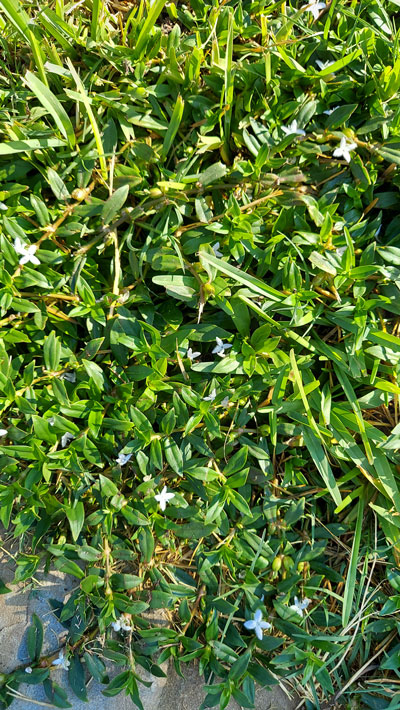
Answer: You’ve “chosen” a particularly difficult weed to eliminate. Broadleafed weedkillers containing 2,4-D are your best option. You’ll need to start in the early spring as things begin to green up and then go after it repeatedly into the summer. Once it gets really warm (high 80s or into the 90s) you’ll need to spot-treat if you have St. Augustine, as it can be burned by the 2,4-D. Hand-pulling is not effective. The weed breaks into small pieces.
I did a little searching of what the better southern ag schools had to suggest. Here are some of their posts.
Louisiana State University (This is very good, easy-to-understand information.)
Clemson University (South Carolina)
QUESTION 2
IS TWO-THIRDS SUN ENOUGH FOR DWARF CRAPE MYRTLES?
Question: I’m giving up on hydrangeas and considering dwarf crape myrtles in the front beds. There is a mix of sun and shade with probably two-thirds sun exposure. I love their colors, but would they work there? Terri C., Trenton, Fannin Co.
Answer: Two-thirds would mean approximately 8 hours of hot, direct summer sun from May through September. If that 8-hour period of time began at 10 a.m. and ran until 6 p.m., I could agree to that. (I’m almost smiling as I type that.) I find, however, that folks usually under-estimate the amount of sunlight an area receives in the hopes that they can wish it to qualify. Plus, the shade is often caused by trees overhead, and those trees continue to grow and cast more shade. I would suggest planting compact nandinas (Nandina domestica ‘Compacta’) and dwarf Burford hollies for parts of the area. Both give good color in winter and very acceptable good looks during the growing season. You could nestle a limited number of dwarf crape myrtles into a cluster within them to see how they do. If they fail, at least the entire bed wouldn’t be lost. You could then replace them with something else.
QUESTION 3
WHY WOULD DYNAMITE CRAPE MYRTLES CHANGE FROM DEEP RED TO A MIX OF WHITE AND PINK BLOOMS?
Question: My 7-year-old Dynamite crape myrtles have changed from deep red to a mix of white and pink blooms. Can anything be done about this? Jack K., Bryan.

Answer: If this has been going on for all this summer then you have a couple of errant cuttings that somehow made it into the pot at the time the Dynamite was planted.
However, my second thought is more likely. Mark Byers of Byers Wholesale Nursery in Alabama (now closed) pointed this out to me in a TNLA Nursery Expo 15 years ago: When a red crape myrtle blooms in cloudy weather (or indoors in a trade show), its flowers open up a pale pink or white color. It happens frequently. I’ve seen it many times since Mark explained it to me. It’s nothing to worry about. The plant will return to red flowers next time it blooms as long as it’s not cloudy.
(The photo I have included is one I took June 17 in Stonebridge Ranch, McKinney, following several cloudy days. It shows a Dynamite crape myrtle with the pink blooms you described. If you look closely you’ll even see several small flowers that have opened almost pure white. They look like tiny pieces of popcorn.)
QUESTION 4
WHAT CAN I DO FOR THIS GARNET JAPANESE MAPLE?
Question: I planted a 10-gal. Garnet Japanese maple last April. In the past month most of the leaves have browned. The surrounding soil was amended heavily with compost and two sprinkler nozzles spray directly on this maple for 10 minutes at 6 a.m. daily. Bob W., The Colony.
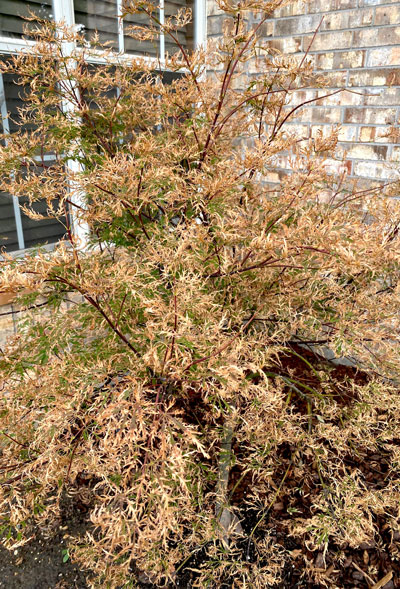
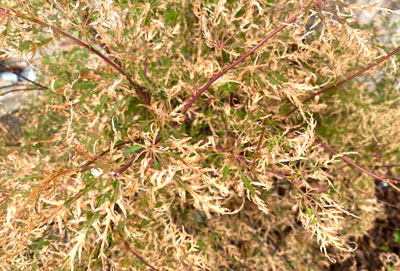
Answer: This is totally sunscald. You are going to have to move this plant to a spot that receives no direct sunlight once it has gone dormant this winter. No amount of water, mulch or fertilizer is going to compensate for the burning effects of the sun’s rays. This is the same thing that happened to the Emperor Japanese maple that Lindsey S. from Murphy asked about here last week. See Question 2.
QUESTION 5
WHAT GRASS SEED IS RESISTANT TO TARR?
Question: My St. Augustine has been decimated by take all root rot – from being absolutely lush and thick last year to brown sprigs this year. I’ve applied a fungicide twice with no improvement. What grass seed is resistant to this disease? Stacey C., Garland.
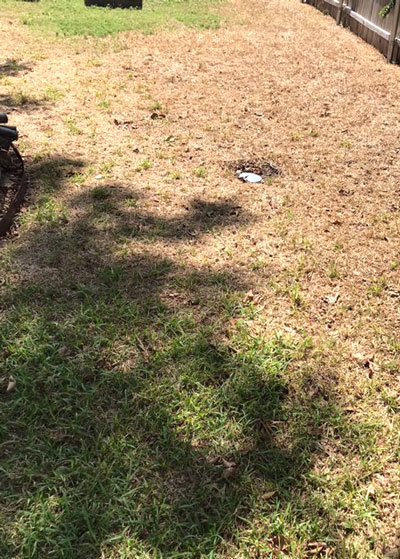
Answer: Seed? That is going to limit you to common bermudagrass or fescue. You don’t want fescue in Garland, so I guess bermuda is the only answer I can give you. However, I do not believe this damage was done by TARR! This looks much more like damage done by chinch bugs. Please see this diagnostic information I have left archived on my website. TARR rarely kills entire areas of St. Augustine so completely, plus it attacks in April and May. Normally people wouldn’t wait until now to ask about it. Chinch bugs show up in mid- to late summer. If this were my lawn, and if I had St. Augustine everywhere else, I would replace the dead areas with more St. Augustine, but I would be on the lookout each summer for early signs of chinch bug invasions.
QUESTION 6
WHY HAS PECAN STOPPED PRODUCING PECANS? BARK IS SEPARATING.
Question: I have a pecan tree that has stopped producing pecans. Now I notice the bark is separating at the base of the trunk. What can I do? Michael S., Plano.


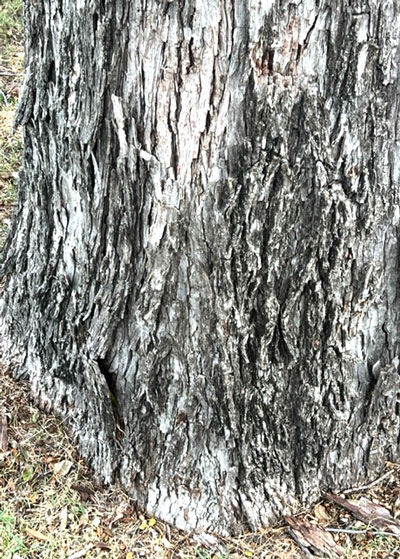
Answer: Let me take the chance of insulting both of our intelligences. The most distant of your three photos shows foliage at its top, but it’s not pecan leaves. It looks more like leaves of a conifer, perhaps eastern redcedar. So that threw me off course a bit. I live in a pecan forest, and this trunk somehow didn’t look quite right. That would certainly account for not having pecans.
But, for the sake of giving you an honorable answer, I’ll assume that it is a pecan. The root flare is covered up by soil. You might want to have an arborist look at the tree to see if it might need to have its root flare exposed with an air spade.
Pecans also are “alternate bearers,” meaning that they will have one or more “down” years between good crops. It’s been three or four years since our trees produced very well outside McKinney (less than 15 miles from you).
This year has been especially rough on them. The pecans that they have managed to produce are much reduced in size because of the drought. (I don’t irrigate our 11 acres.)
I’m not sure which part of my answer applies best to your situation, but it’s in there somewhere. I can’t see enough of the tree and I don’t know enough of its past to be more definitive.
QUESTION 7
WHY ARE CHITALPA BRANCHES BROWNING?
Question: I planted this chitalpa early this spring. It suddenly has branches browning. I have removed one branch and now another one is browning. What can I do? Lora O., Williamson Co.
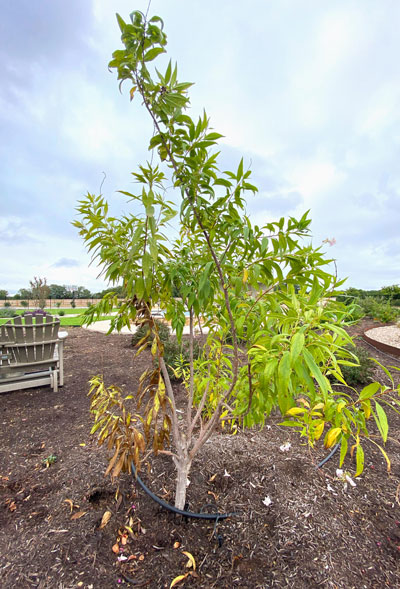
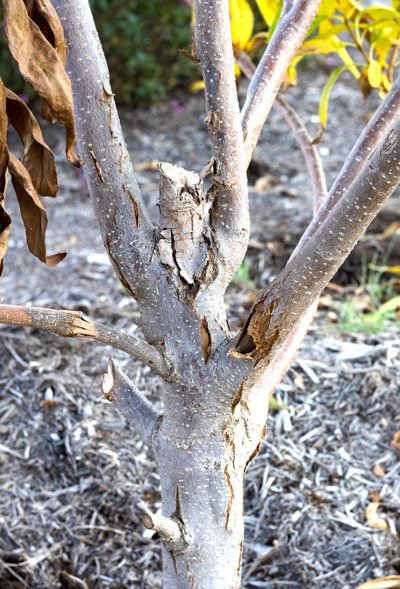
Answer: Notice the stub in the center of the trunk. It looks like it was probably cut first, and it is not healing well at all. Anytime you remove a branch you need to make the cut virtually flush with the remaining trunk or limb. That will allow new bark to grow over the wound so that the plant can heal. Decay has set into the trunk and the bark is splitting. The intense summer sun could also have damaged the bark of the trunk.
You’ll probably have more pruning ahead of you, probably major pruning at that, as you try to reshape the plant and help it recover. Hopefully you’ll be able to save it. Just be careful from now on not to leave stubs.
QUESTION 8
WHY DID HALTS NOT STOP THIS WEED?
Question: What is this weed called? I’ve used Halts pre-emergent according to your application times this year. Any suggestions? Nixie R., Ellis Co.
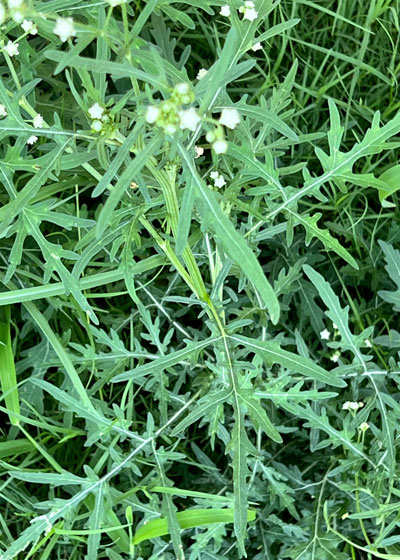
Answer: I’ll leave the naming of this weed up to an agronomist or taxonomist. It’s more of an agricultural weed than one we normally would see in a home lawn. However, it’s a broadleafed weed and obviously not a grass. Halts is primarily intended for use in preventing annual grassy weeds such as crabgrass and grassburs in spring and summer and annual bluegrass, rescuegrass and ryegrass in winter and spring. It, along with Balan and Dimension, would not be as successful in preventing broadleafed weeds like this. A broadleafed weedkiller spray containing 2,4-D would control this very handily. Read and follow label directions for best results.
QUESTION 9
HOW CAN I GET BETTER SHAPE FROM MY CRAPE MYRTLE?
Question: This crape myrtle was planted by our builder three years ago. It didn’t bloom well until this year, and it is developing a poor shape. How can I fix it? Stephanie G., Heath, Kaufman Co.
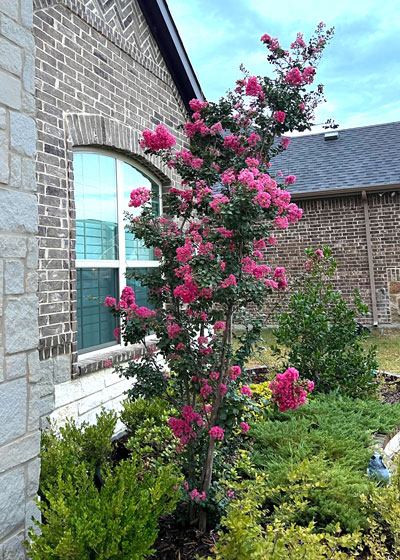
Answer: You’ve probably experienced a houseplant indoors that grew toward a window. A botany professor once explained to us that plants actually “grow away from darkness.” The cells have a growth hormone that results in cell elongation. That hormone is destroyed by light, causing the dark sides of stems to lengthen and the stems to lean toward the light source.
That’s what your crape myrtle is doing. Any plant that you grow in this spot is going to lean out away from the wall. The only way you could have a symmetrical crape myrtle would be to dig and relocate it 12 or 14 feet out from the wall so that it would receive light from all directions. You would do that transplanting in the winter while the plant is dormant. This crape myrtle is far too close to the house. It does need to be moved for the good of the house.
QUESTION 10
HOW DOES ONE ELIMINATE PEPPERVINE?
Question: I believe this obnoxious weed is called peppervine. How can I eliminate it? I’ve tried digging it out, herbicides and just cutting it back, but it keeps coming back stronger. Suzanne T., College Station.
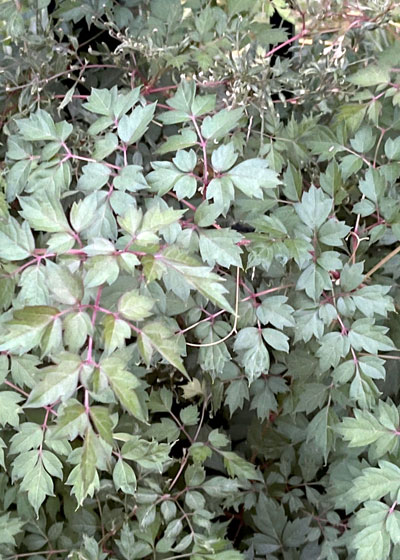
Answer: What I have done for peppervine, snailseed vine and other invasive perennial vines is to cut them off at the ground, then cover the bed with a roll-type mulch. I overlap the mulch at its seams by 3 or 4 inches so the vine can’t sneak up through the joints and I spread 2-3 inches of pine bark mulch or compost over the top of the roll mulch to conceal it. I leave that in place for a couple of years. By then the vine should be choked out.
QUESTION 11
WHAT HAS HAPPENED TO SHANTUNG MAPLE SUDDENLY?
Question: I planted this Shantung maple last fall. It has done great all year, but now, after the 5-inch rain last week the tree looks diseased. What happened? Mindy B., Fort Worth.
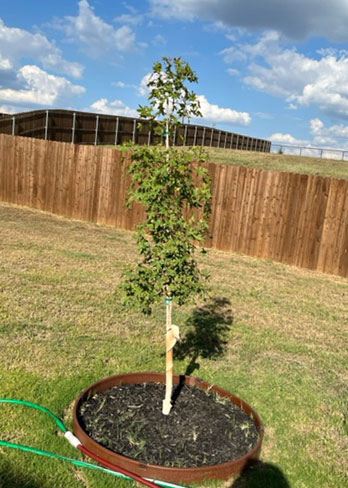
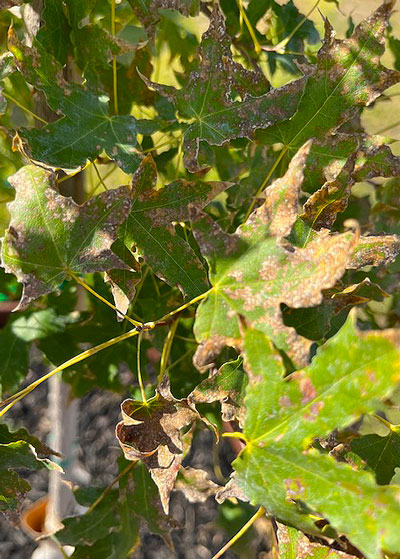
Answer: If it’s a disease it’s not of any major importance at this point. It may just be the impact of a very hot summer. Keep it moist all fall and winter and it should leaf out completely normally next spring.
QUESTION 12
WHY DOES ONE CRAPE MYRTLE HAVE THE BROWN BRANCH?
Question: What is going on with my crape myrtle? Of the four, this one has one brown branch. Is there anything I need to do besides cutting it out? Marsha K., Allen.
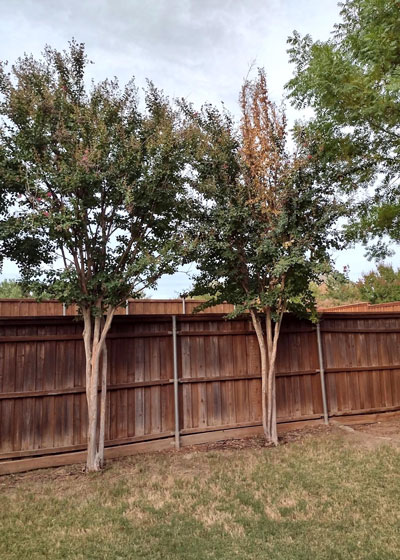
Answer: I can’t see it well enough to tell if that branch is dead clear back to the ground or just at its tips. It could be a separate cutting of a different variety that wasn’t as winter hardy. It’s quite common for them to get mixed together out of the propagation bench. Some crape myrtles are still dying back from cold of the past two years. I know that sounds like a random answer, but I can’t zoom in on the photo enough to tell much else. Trace the dead portion back and perhaps you can tell what has happened. Cut it out and see if the plant offers to regrow.
